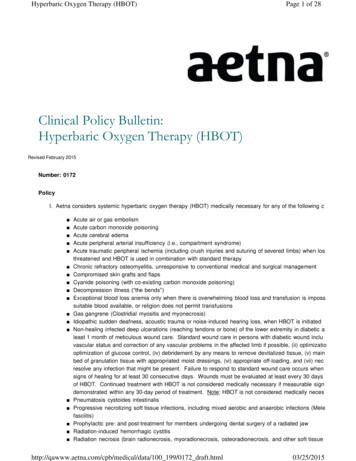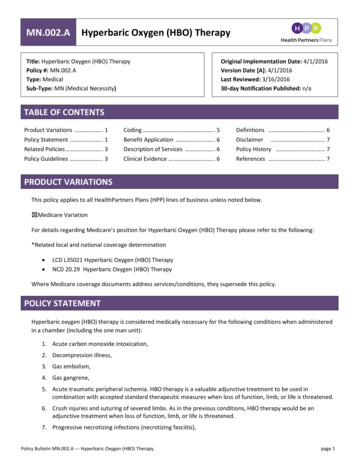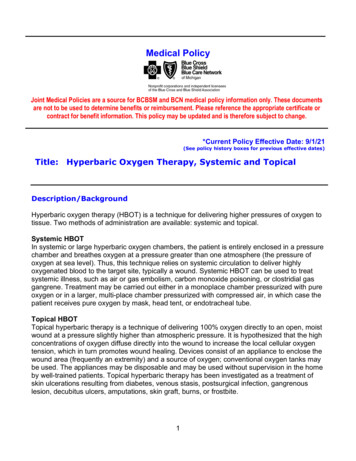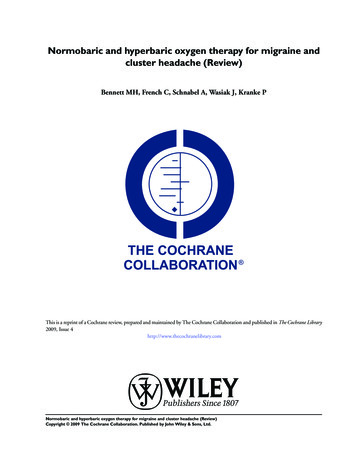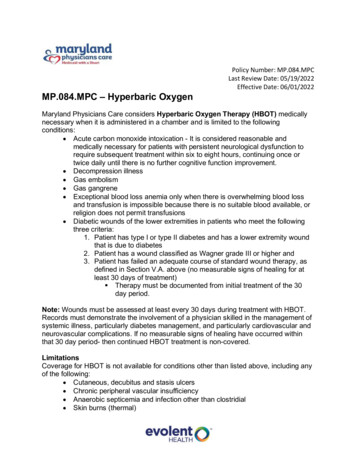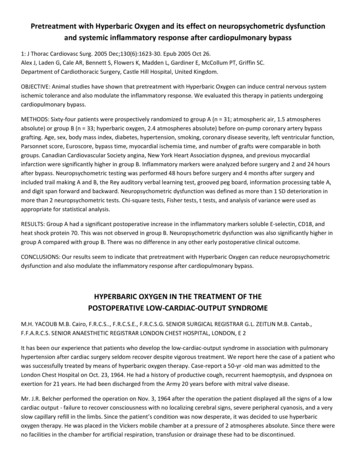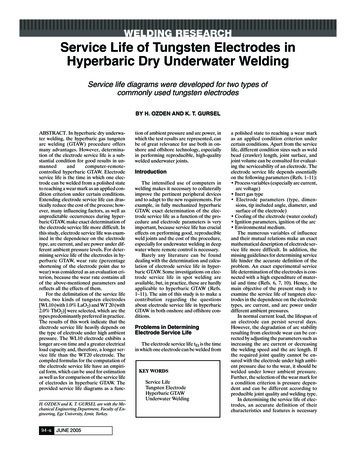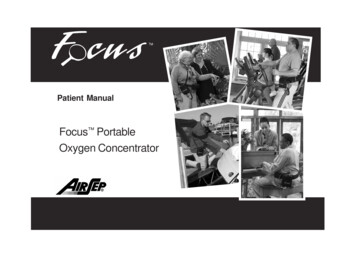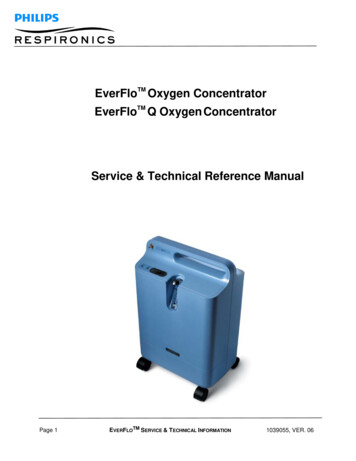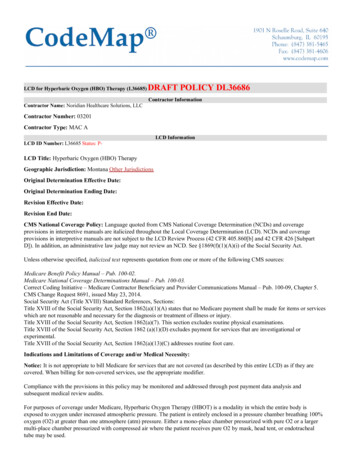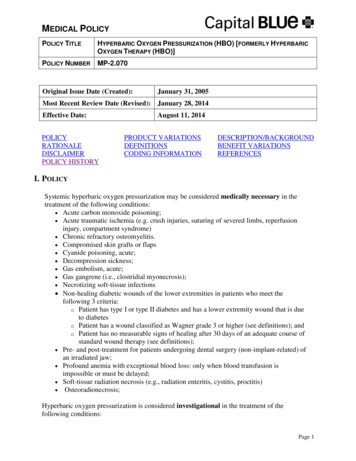
Transcription
MEDICAL POLICYPOLICY TITLEHYPERBARIC OXYGEN PRESSURIZATION (HBO) [FORMERLY HYPERBARICOXYGEN THERAPY (HBO)]POLICY NUMBERMP-2.070Original Issue Date (Created):January 31, 2005Most Recent Review Date (Revised): January 28, 2014Effective Date:POLICYRATIONALEDISCLAIMERPOLICY HISTORYAugust 11, 2014PRODUCT VARIATIONSDEFINITIONSCODING INFORMATIONDESCRIPTION/BACKGROUNDBENEFIT VARIATIONSREFERENCESI. POLICYSystemic hyperbaric oxygen pressurization may be considered medically necessary in thetreatment of the following conditions: Acute carbon monoxide poisoning; Acute traumatic ischemia (e.g. crush injuries, suturing of severed limbs, reperfusioninjury, compartment syndrome) Chronic refractory osteomyelitis. Compromised skin grafts or flaps Cyanide poisoning, acute; Decompression sickness; Gas embolism, acute; Gas gangrene (i.e., clostridial myonecrosis); Necrotizing soft-tissue infections Non-healing diabetic wounds of the lower extremities in patients who meet thefollowing 3 criteria:o Patient has type I or type II diabetes and has a lower extremity wound that is dueto diabeteso Patient has a wound classified as Wagner grade 3 or higher (see definitions); ando Patient has no measurable signs of healing after 30 days of an adequate course ofstandard wound therapy (see definitions); Pre- and post-treatment for patients undergoing dental surgery (non-implant-related) ofan irradiated jaw; Profound anemia with exceptional blood loss: only when blood transfusion isimpossible or must be delayed; Soft-tissue radiation necrosis (e.g., radiation enteritis, cystitis, proctitis) Osteoradionecrosis;Hyperbaric oxygen pressurization is considered investigational in the treatment of thefollowing conditions:Page 1
MEDICAL POLICYPOLICY TITLEHYPERBARIC OXYGEN PRESSURIZATION (HBO) [FORMERLY HYPERBARICOXYGEN THERAPY (HBO)]POLICY NUMBERMP-2.070 Acute arterial peripheral insufficiency;Acute coronary syndromes and as an adjunct to coronary interventions, including butnot limited to, percutaneous coronary interventions and cardiopulmonary bypass;Acute ischemic stroke;Acute osteomyelitis, refractory to standard medical management;Acute surgical wounds;Acute thermal burns;Autism spectrum disorders;Bell’s palsyBone grafts;Brown recluse spider bites;Carbon tetrachloride poisoning, acute;Cerebral edema, acute;Cerebral palsy;Cerebrovascular disease, acute (thrombotic or embolic) or chronic;Chronic arm lymphedema following radiotherapy for cancer;Chronic wounds, other than those in patients with diabetes who meet the criteriaspecified in the medically necessary statement;Delayed onset muscle soreness;Demyelinating diseases, e.g., multiple sclerosis, amyotrophic lateral sclerosis;Early treatment (beginning at completion of radiation therapy) to reduce adverse effectsof radiation therapy; andFracture healing;Herpes ZosterHydrogen sulfide poisoning;Idiopathic femoral neck necrosis;Idiopathic sudden sensorineural hearing loss;In vitro fertilization;Intra-abdominal and intracranial abscesses;Lepromatous leprosy;Meningitis;Migraine;Motor function associated with stroke;Osteonecrosis of the jaw – bisphosphonate-related;Pseudomembranous colitis (antimicrobial agent-induced colitis);Pyoderma gangrenosum;Radiation myelitis;Page 2
MEDICAL POLICYPOLICY TITLEHYPERBARIC OXYGEN PRESSURIZATION (HBO) [FORMERLY HYPERBARICOXYGEN THERAPY (HBO)]POLICY NUMBERMP-2.070 Radiation-induced injury in the head and neck;Refractory mycoses: mucormycosis, actinomycosis, canidiobolus coronato;Retinal artery insufficiency, acute;Retinopathy, adjunct to scleral buckling procedures in patients with sickle cellperipheral retinopathy and retinal detachment;Severe or refractory Crohn’s disease;Sickle cell crisis and/or hematuria;Spinal cord injury;Traumatic brain injury;Tumor sensitization for cancer treatments, including but not limited to, radiotherapy orchemotherapy;Vascular dementiaTopical hyperbaric oxygen therapy is considered investigational, as there is insufficientevidence to support a conclusion concerning the health outcomes or benefits associated with thisprocedure.NOTE: Refer to the appendix at the end of the policy for the Undersea and HyperbaricMedical Society’s 2008 Hyperbaric Oxygen Therapy Committee report forsuggestions on utilization for specific indications.Cross-reference:MP-2.304 Pervasive Developmental DisordersII. PRODUCT VARIATIONSTOP[N] No product variation, policy applies as stated[Y] Standard product coverage varies from application of this policy, see below[N] Capital Cares 4 Kids[N] Indemnity[N] PPO[N] SpecialCare[N] HMO[N] POS[Y] SeniorBlue HMO*[Y] FEP PPO*[Y] SeniorBlue PPO*Page 3
MEDICAL POLICYPOLICY TITLEHYPERBARIC OXYGEN PRESSURIZATION (HBO) [FORMERLY HYPERBARICOXYGEN THERAPY (HBO)]POLICY NUMBERMP-2.070* Refer to Novitas Solutions Local Coverage Determination (LCD) L32018. Hyperbaric Oxygen(HBO) Therapy.**Refer to FEP Medical Policy Manual MP-2.01.04 Hyperbaric Oxygen Pressurization. The FEPMedical Policy manual can be found at: www.fepblue.orgIII. DESCRIPTION/BACKGROUNDTOPHyperbaric oxygen therapy (HBO) involves breathing 100% oxygen at a pressure of more than1 atmosphere (atm). Hyperbaric oxygen therapy is generally applied systemically with thepatient inside a hyperbaric chamber. It can also be applied topically; that is, the body part to betreated is isolated e.g., in an inflatable bag and exposed to pure oxygen.Hyperbaric oxygen therapy (HBO) is a technique of delivering higher pressures of oxygen tothe tissues. Two methods of administration are available. In systemic or large chamberhyperbaric oxygen, the patient is entirely enclosed in a pressure chamber and breathes oxygenat a pressure greater than 1 atmosphere (atm, the pressure of oxygen at sea level). Thus, thistechnique relies on systemic circulation to deliver highly oxygenated blood to the target site,typically a wound. In addition, systemic hyperbaric oxygen therapy can be used to treatsystemic illness, such as air or gas embolism, carbon monoxide poisoning, clostridial gasgangrene, etc. Treatment may be carried out either in a monoplace chamber pressurized withpure oxygen or in a larger, multiplace chamber pressurized with compressed air, in which casethe patient receives pure oxygen by mask, head tent, or endotracheal tube.Topical hyperbaric oxygen therapy is a technique of delivering 100% oxygen directly to an open,moist wound at a pressure slightly higher than atmospheric pressure. It is hypothesized that thehigh concentrations of oxygen diffuse directly into the wound to increase the local cellularoxygen tension, which in turn promotes wound healing. Topical hyperbaric oxygen devicesconsist of an appliance to enclose the wound area (frequently an extremity) and a source ofoxygen; conventional oxygen tanks may be used. The appliances may be disposable and may beused without supervision in the home by well-trained patients. Topical hyperbaric oxygentherapy has been investigated as a treatment of skin ulcerations resulting from diabetes, venousstasis, postsurgical infection, gangrenous lesion, decubitus ulcers, amputations, skin graft, burns,or frostbite.Regulatory StatusIn February 1999, the Numobag kit (Numotech, Inc; Woodland Hills, CA) for application oftopical hyperbaric therapy was cleared for marketing by the U.S. Food and Drug Administration(FDA) through the 510(k) process. The FDA determined that this device was substantiallyequivalent to existing devices.Page 4
MEDICAL POLICYPOLICY TITLEHYPERBARIC OXYGEN PRESSURIZATION (HBO) [FORMERLY HYPERBARICOXYGEN THERAPY (HBO)]POLICY NUMBERMP-2.070In May 2005, the ATA Monoplace Hyperbaric System (ATA Hyperbaric ChamberManufacturing, Inc) was cleared for marketing by the FDA through the 510(k) process. The FDAdetermined that this device was substantially equivalent to existing hyperbaric devices.IV. RATIONALETOPTopical Hyperbaric OxygenDue to their different methods of delivery, topical and systemic hyperbaric oxygen (HBO) aredistinct technologies such that they must be examined separately. At the time of policydevelopment, there was minimal published literature regarding topical hyperbaric oxygentherapy. The literature primarily consists of case reports or small uncontrolled case series. (2,3) There was one small randomized controlled trial (RCT) that included 18 patients withdiabetic foot ulcers who were assigned to receive either topical hyperbaric oxygen therapy plusstandard wound care or standard wound care alone. (4) Changes in ulcer size and depth did notdiffer between the 2 groups.Systemic Hyperbaric OxygenThe original policy on systemic HBO was based entirely on the 1996 guidelines published bythe Undersea and Hyperbaric Medical Society (UHMS) and was subsequently revised in 1999with 3 TEC Assessments. (5-7) The TEC Assessments had conclusions similar to UHMS,except, in contrast to the UHMS guidelines, they concluded that there was insufficient evidenceto conclude that HBO treatment improved the net health outcome for the following indications: compromised skin graftsacute thermal burnschronic refractory osteomyelitisnecrotizing soft tissue infectionsbrown recluse spider bitesThe TEC Assessments also concluded that there was insufficient evidence to permitconclusions on the use of HBO for treatment of brain injury; spinal cord injury; and Crohn’sdisease, indications not addressed by the 1996 UHMS Guidelines. Literature updates havefocused on identifying new RCTs and meta-analyses of RCTs, particularly on indicationsconsidered investigational at the time of the update.Chronic WoundsAn updated Cochrane review of RCTs on HBO treatment for chronic wounds was published byKranke and colleagues in 2012. (8) The authors identified 9 RCTs with a total of 471participants that compared the effect of HBO on chronic wound healing compared to analternative treatment approach that did not use HBO. Eight of the 9 trials included in the reviewevaluated HBO therapy in patients with diabetes. The remaining trial addressed HBO forPage 5
MEDICAL POLICYPOLICY TITLEHYPERBARIC OXYGEN PRESSURIZATION (HBO) [FORMERLY HYPERBARICOXYGEN THERAPY (HBO)]POLICY NUMBERMP-2.070patients with venous ulcers; that study had only 16 participants and the comparator treatmentwas not specified. In a pooled analysis of data from 3 trials, a significantly higher proportion ofulcers had healed at the end of the treatment period (6 weeks) in the group receiving HBOcompared to the group not receiving HBO (risk ratio [RR]: 5.20: 95% confidence interval [CI]:1.25 to 21.7). Pooled analyses, however, did not find significant differences between groups inthe proportion of ulcers healed in the HBO versus non-HBO-treated groups at 6 months (2trials) or 12 months (3 trials). There were insufficient data to conduct pooled analyses ofstudies evaluating HBO for treating patients with chronic wounds who did not have diabetes.The most recently published trial conducted with diabetic patients was double-blind andincluded 75 diabetic patients with chronic wounds who had failed at least 2 months oftreatment at a diabetic foot clinic. (9) After 12 months, the healing rate was 61% in thehyperbaric oxygen group and 27% in the sham hyperbaric group; this difference wasstatistically significant, p 0.009.Based on the above evidence, HBO therapy for chronic severe diabetic ulcers may beconsidered medically necessary, and HBO treatment for other types of chronic wounds isconsidered investigational.Acute Surgical and Traumatic WoundsIn 2011, a Cochrane review of RCTs on HBO therapy for acute wounds (e.g., surgical wounds,lacerations, traumatic wounds, and animal bites) was published by Eskes and colleagues. (10)To be included, studies needed to compare HBO with a different intervention or compare 2HBO regimens; in addition, studies needed to objectively measure wound healing. A total of 7potentially relevant studies were identified; 3 of these met the review’s inclusion criteria. The 3studies ranged in size from 36 to 135 participants. Due to differences among studies in terms ofpatient population, comparison intervention, outcome measurement, etc., study results couldnot be pooled. In addition, investigators identified biases in the studies such as insufficientreporting of randomization procedures and selective reporting of outcome data. Findings ofindividual studies were mixed. For example, one study found a significantly higher rate ofcomplete wound healing with HBO compared to sham HBO treatment, and another study didnot find a significant difference in complete healing rates between HBO therapy anddexamethasone or heparin treatment. The authors concluded that there is insufficient highquality data on the effect of HBO therapy on treatment of acute wounds.Carbon Monoxide PoisoningA 2011 Cochrane review of 7 RCTs concluded that the available evidence is insufficient todetermine whether adverse neurologic outcomes in patients with carbon monoxide poisoningare reduced with HBO therapy. (11) In 2008, the American College of Emergency Physicianspublished a clinical policy on critical issues in carbon monoxide poisoning. (12) Theirliterature review indicated there was only Level C evidence (preliminary, inconclusive, orconflicting evidence) for treatment of acute carbon monoxide poisoning. The 2008 Underseaand Hyperbaric Medical Society (UHMS), however, lists carbon monoxide poisoning as anindication for HBO therapy.Page 6
MEDICAL POLICYPOLICY TITLEHYPERBARIC OXYGEN PRESSURIZATION (HBO) [FORMERLY HYPERBARICOXYGEN THERAPY (HBO)]POLICY NUMBERMP-2.070Two blinded randomized trials were discussed in both the Cochrane and American College ofEmergency Physicians reviews. One is a study by Scheinkestel and colleagues, a double-blind,RCT comparing HBO to normobaric oxygen in patients with carbon monoxide poisoning. (13)The authors reported that HBO therapy did not benefit patient outcomes of neuropsychologicperformance when HBO therapy was completed and at 1-month follow-up. This study waslimited, however, by a high rate (46%) of patients who were lost to follow-up. Moreover, thetrial has been criticized for administrating 100% normobaric oxygen for at least 72 hoursbetween treatments, which has been called a toxic dose of oxygen. (14) The critiques alsomention that there was an unusually high rate of neurologic sequelae after the treatment period,which could be due in part to the high dose of oxygen and/or the high rate of cognitivedysfunction in the study population (69% were poisoned by carbon monoxide through suicideattempts).The other blinded trial by Weaver and colleagues also compared HBO and normobaric oxygen.(15) Patients received either 3 sessions of HBO or 1 session of normobaric oxygen plus 2sessions of exposure to normobaric room air. The primary outcome was the rate of cognitivesequelae at 6 weeks. Cognitive function was assessed by a battery of neuropsychological tests.At the 6-week follow-up, the intention-to-treat analysis found that 19 of 76 (25.0%) in theHBO group and 35 of 76 (46.1%) in the control group had cognitive sequelae; the differencewas statistically significant, p 0.007. There was a high rate of follow-up at 6 weeks, 147 of152 (97%) of randomized patients. Enrollment in the study was stopped early because aninterim analysis found HBO to be effective. A follow-up study, that included 147 patients fromthe randomized trial and 75 who had been eligible for the trial but had not enrolled, waspublished in 2007. (16) Of the group treated with HBO (n 75), cognitive sequelae wereidentified in 10 of 58 (17%) at 6 months and 9 of 62 (14%) at 12 months. Of the group nottreated with HBO (n 163), 44 of 146 (30%) at 6 months and 27 of 149 (18%) at 12 months hadcognitive sequelae. (The follow-up rate was higher at 12 months because the investigatorsreceived additional funding for data collection). Thus, in light of the clinical studies, includingthe limitations of trials noted above, and given the strong clinical support for this treatment (seeClinical Input section below), the use of hyperbaric oxygen therapy for acute carbon monoxidepoisoning may be medically necessary.Radionecrosis and OsteoradionecrosisA 2008 Cochrane review by Esposito et al. reviewed the use of HBO therapy in patientsrequiring dental implants. (17) The authors identified 1 randomized trial involving 26 patients.The authors concluded that despite the limited amount of clinical research available, it appearsthat HBO therapy in irradiated patients requiring dental implants may not offer any appreciableclinical benefits. They indicate that there is a need for more RCTs to ascertain the effectivenessof HBO in irradiated patients requiring dental implants.In 2012, Bennett and colleagues published a Cochrane review on hyperbaric oxygen therapyfor late radiation tissue injury. (18) The authors identified 11 RCTs; there was variabilityamong trials and study findings were not pooled for the primary outcomes of survival,complete resolution of necrosis or tissue damage, and improvement in a late effects symptomPage 7
MEDICAL POLICYPOLICY TITLEHYPERBARIC OXYGEN PRESSURIZATION (HBO) [FORMERLY HYPERBARICOXYGEN THERAPY (HBO)]POLICY NUMBERMP-2.070scale. In a pooled analysis of 3 studies, a significantly higher proportion of patients withosteoradionecrosis achieved complete mucosal cover after hyperbaric oxygen treatmentcompared to control (RR: 1.30, 95% CI: 1.09 to 1.55). From their review of the literature, theauthors concluded that data from small trials “suggest that for people with LRTI (LateRadiation Tissue Injury) affecting the head, neck, anus, and rectum, [HBO] is associated withimproved outcome. HBO also appears to reduce the chance of ORN (osteoradionecrosis)following tooth extraction in an irradiated field. There was no such evidence of any importantclinical effect on neurological tissues. The application of HBOT to selected patients and tissuesmay be justified.”In 2012, Shao and colleagues in China published an RCT including 36 patients who hadundergone radiotherapy for pelvic malignancies and had radiation-induced hemorrhagiccystitis. (19) Patients were randomized to treatment with hyaluronic acid (n 16) or hyperbaricoxygen (n 20). The hyaluronic acid group received weekly injections for the first month andmonthly injections for the following 2 months. HBO treatment consisted of 30-minute sessionsdaily for one month. All patients completed the study. There were no statistically significantdifferences in outcomes e.g., pain or voids per day 6, 12, or 18 months after treatment. Forexample, at 12 months after treatment, the number of voids per day was 8.9 in the hyaluronicacid group and 9.7 in the HBO group, p 0.05. The study may have been underpowered todetect statistically significant differences between groups.In summary, given the longstanding use of this technology, the existing literature base, and theCochrane reviews noted above, the use of HBO therapy for treatment of soft tissue and boneradiation necrosis and for pre- and post-treatment of dental surgery (non-implant-related) in anirradiated jaw may be considered medically necessary.Bisphosphonate-related Osteonecrosis of the JawAn unblinded RCT was published by Freiberger and colleagues in 2012 on use of HBO as anadjunct therapy for patients with bisphosphonate-related osteonecrosis of the jaw. (20) Fortynine patients were randomly assigned to HBO in addition to standard care (n 22) or standardcare alone (n 27). Five patients in the standard care group received HBO treatment and 1patient assigned to the HBO group declined HBO. The investigators decided to do a perprotocol analysis (actual treatment received) because of the relatively large degree ofcrossover. Participants were evaluated at 3, 6 12 and 18 months. Data were available on 46patients, 25 received HBO in addition to standard care and 21 received standard care alone.The primary outcome measure was change in oral lesion size or number. When change frombaseline to last available follow-up was examined, 17 of 25 (68%) of HBO-treated patients hadimprovement in oral lesion size or number compared to 8 of 21 (38%) in the standard caregroup, p 0.043. When change from baseline to 6, 12 or 18 months was examined, there wasnot a statistically significant difference between groups in the proportion of patients withimprovement. In addition, the proportion of patients who healed completely did not differsignificantly between groups at any time point. This single trial does not report consistentfindings of benefit across outcome measures. It also has a number of methodologic limitations,e.g., unblinded, cross-over, and analysis performed on a per-protocol basis rather than intentionPage 8
MEDICAL POLICYPOLICY TITLEHYPERBARIC OXYGEN PRESSURIZATION (HBO) [FORMERLY HYPERBARICOXYGEN THERAPY (HBO)]POLICY NUMBERMP-2.070to treat. A disadvantage of the per-protocol analysis is that randomization is not preserved, andthe two groups may differ on characteristics that affect outcomes. As a result, this trial isinsufficient to conclude that HBO improves health outcomes for patients with bisphosphonaterelated osteonecrosis of the jaw.OsteomyelitisNo prospective clinical trials on chronic refractory osteomyelitis or acute refractoryosteomyelitis were identified in updated searches. The justification for the use of HBO inchronic osteomyelitis has been primarily based on case series. Among the larger case series,Maynor and colleagues reviewed the records of all patients with chronic osteomyelitis of thetibia seen at one institution. (21) Follow-up data were available on 34 patients who hadreceived a mean of 35 adjunctive HBO treatments (range, 6 to 99). Of the 26 patients with atleast 2 years of follow-up after treatment, 21 (81%) remained drainage-free. Twelve of 15(80%) with follow-up data at 60 months had remained drainage-free. A study by Davis andcolleagues reviewed outcomes for 38 patients with chronic refractory osteomyelitis treated atanother U.S. institution. (22) Patients received HBO treatment until the bone was fullyrecovered with healthy vascular tissue; this resulted in a mean of 48 daily HBO treatments(range, 8 to 103). After a mean post-treatment follow-up of 34 months, 34 of 38 (89%) patientsremained clinically free of infection (i.e., drainage-free and no tenderness, pain, or cellulitis).Success rates from several smaller case series, all conducted in Taiwan, are 12 of 13 (92%)patients, 11 of 14 (79%) patients, and 13 of 15 (86%) patients. (23-25) Given the highpercentage of refractory patients in these series who had successful outcomes and the clinicalsupport for HBO as a treatment option for chronic refractory osteomyelitis (see Clinical Inputsection below), the use of HBO therapy for chronic refractory osteomyelitis may be consideredmedically necessary. HBO treatment for acute osteomyelitis refractory to medical treatmentmay be considered investigational.Fracture HealingIn 2012, Bennett and colleagues published a Cochrane review on HBO to promote fracturehealing and treat non-union fractures. (26) The investigators did not identify any publishedRCTs on this topic that compared HBO to no treatment, sham or another intervention andreported bony union as an outcome. Due to the lack of RCTs, it is not possible to concludewhether the use HBO to promote fracture healing improves outcomes; therefore, the use ofHBO for this indication is considered investigational.Compromised Skin Grafts and FlapsIn 2006, Friedman and colleagues published a systematic review of literature on use of HBOfor treating skin flaps and grafts. (27) No RCTs were found. The authors identified 2retrospective case series on use of HBO for clinically compromised skin grafts and flaps. Theseries had sample sizes of 65 and 26, respectively; both were published in the 1980s based ontreatment provided in the 1970s and 1980s. Given the limited published data and lack of recentdata, this indication remains investigational.Page 9
MEDICAL POLICYPOLICY TITLEHYPERBARIC OXYGEN PRESSURIZATION (HBO) [FORMERLY HYPERBARICOXYGEN THERAPY (HBO)]POLICY NUMBERMP-2.070Necrotizing Soft Tissue InfectionsA 2005 systematic review by Jallali and colleagues evaluated the literature on HBO asadjunctive therapy for necrotizing fasciitis. (28) They did not identify any RCTs. There wereonly a few retrospective studies with small sample sizes and findings were inconsistent. Theauthors concluded that more robust evidence is needed before widespread use of HBO isrecommended. A 2009 retrospective cohort study compared outcomes in 48 patients at 1 centerwho received adjunctive HBO for necrotizing soft issue infections to those in 30 patients at adifferent center who did not receive HBO. (29) There was not a significant difference in themortality rate between the 2 groups; this was 4 of 48 (8%) in the HBO group and 4 of 30 (13%)in the non-HBO group (p 0.48). The median number of days in the intensive care unit and themedian number of days in the hospital also did not differ significantly. There was a highermedian number of debridement procedures per person in the HBO group, 3.0 compared to 2.0in the non-HBO group (p 0.03). Thus, based on the available evidence, HBO for necrotizingsoft tissue infections remains investigational.Refractory MycosesNo clinical trials on refractory mycoses (mucormycosis, actinomycosis, conidiobolus coronato)and cerebral edema were found. Therefore, these indications were changed to investigational.Acute Peripheral Arterial InsufficiencyWhile Medicare has long listed acute peripheral arterial insufficiency as a medically necessaryindication, this application was not addressed by previous versions of this policy. No clinicaltrial publications were identified that demonstrated benefit in HBO therapy for acute peripheralarterial insufficiency, and thus the evidence basis of the Medicare policy is unclear. (30) Due tothe lack of published literature, acute peripheral arterial insufficiency was added as aninvestigational indication in this policy.Acute Coronary SyndromesA 2012 Cochrane review by Bennett and colleagues identified 6 trials with a total of 665patients evaluating HBO for acute coronary syndrome. (31) All of the studies included patientswith acute myocardial infarction (MI); one study also included individuals presenting withunstable angina. Additionally, all trials used HBO as an adjunct to standard care. Controlinterventions varied; only 1 trial described using a sham therapy to blind participants totreatment group allocation. In a pooled analysis of data from 5 trials, there was a significantlylower rate of death in patients who received HBO compared to a control intervention (RR:0.58: 0.36 to 0.92). Due to variability of outcome reporting in the studies, few other pooledanalyses could be conducted. A pooled analysis of data from 3 trials on improvements in leftventricular function did not find a statistically significant benefit of HBO treatment (RR: 0.09;95% CI: 0.01 to 1.4). The authors noted that, although there is some evidence from small trialsthat HBO treatment is associated with a lower risk of death, larger trials with highmethodologic quality are needed in order to determine which patients, if any, can be expectedto derive benefit from HBO.Page 10
MEDICAL POLICYPOLICY TITLEHYPERBARIC OXYGEN PRESSURIZATION (HBO) [FORMERLY HYPERBARICOXYGEN THERAPY (HBO)]POLICY NUMBERMP-2.070One of the trials was by Sharifi and colleagues and randomly assigned 69 patients withunstable angina or MI to receive or not receive HBO after a percutaneous coronary intervention(PCI). (32) The 24 patients randomly assigned to the HBO group reported only 1 adverse event(death, MI, coronary artery bypass, or revascularization of target lesion), compared to 13 in the37 control patients. However, this study lacked adequate detail, e.g., on the type of PCIperformed, to permit scientific conclusions. In another RCT of 64 patients, Alex and colleaguesconcluded both neuropsychometric dysfunction and inflammatory response can be reducedpostcardiopulmonary bypass when HBO pretreatment is given. (33) Based on the aboveevidence, the treatment of acute coronary syndromes with HBO is considered investigational.Acute Ischemic StrokeIn a 2005 Cochrane systematic review, Bennett and colleagues evaluated HBO treatment foracute stroke; the content of this review was updated in 2009. (34) The investigators identified 6RCTs with a total of 283 participants that compared HBO to sham HBO or no treatment. Theauthors were only able to pool study findings for 1 outcome; the mortality rate at 3-6 months.A pooled analysis of date from 3 trials did not find a significant benefit of HBO compared to acontrol condition for this outcome (RR: 0.61, 95% CI: 0.17 to 2.20). One of the RCTs waspublished in 2003 by Rusyniak and colleagues. (35) This double-blind trial included 33patients presenting with acute ischemic stroke who were randomly assigned to active or shamHBO. No beneficial effect was reported for HBO therapy compared to sham. Based on theavailable evidence, acute ischemic stroke is considered investigational.Motor Dysfunction Associated with StrokeIn 2013, Efrati and colleagues published an RCT evaluating HBO therapy for treatment ofneurologic deficiencies associated with a history of stroke. (36) The study included 74 patientswith at least 1 motor dysfunction who had an ischemic or hemorrhagic stroke 6-36 monthsprior to study participation. Participants were randomly assigned to receive 2 months of HBOtreatment (40 daily sessions, 5 days per week, n 30) or delayed treatment (n 32). Patientswere evaluated at baseline and 2 months. For patients in the delayed treatment control group,outcomes were evaluated at 4 months after crossing over and receiving HBO treatment.Twenty-nine of 32 patients (91%) in the delayed treatment group crossed over to the activeintervention. Outcome measures included the Nat
Topical hyperbaric oxygen therapy is a technique of delivering 100% oxygen directly to an open, moist wound at a pressure slightly higher than atmospheric pressure. It is hypothesized that the high concentrations of oxygen diffuse directly into the wound to increase the local cellular oxygen tension, which in turn promotes wound healing .
